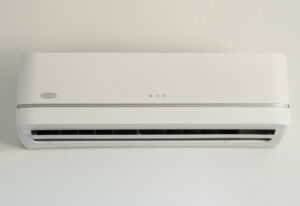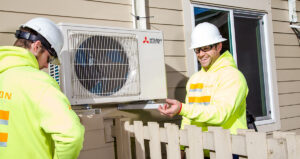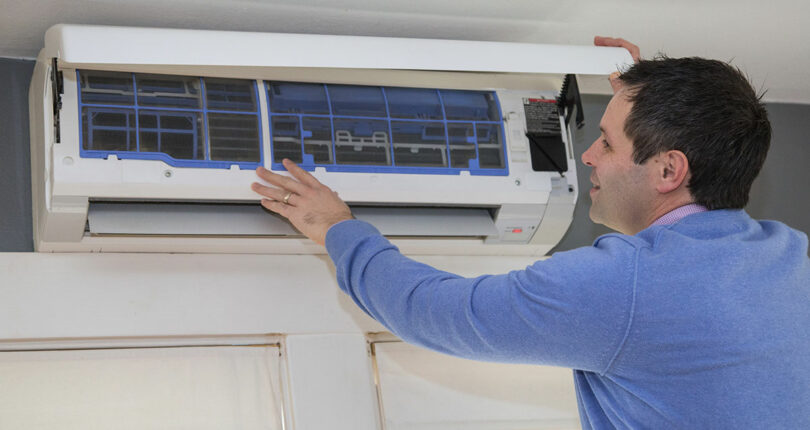Heat pump technology has improved a lot over the past 10–20 years and can be up to 20% more efficient than traditional HVAC systems. Today, heat pumps can operate effectively in subzero weather by switching to electric resistance mode. In extreme cold climates, it may be worth investing in a dual-fuel system where propane or another fuel provides supplemental heat on extremely cold days.
If you are considering upgrading your home heating and cooling system with a heat pump there are several options to consider.
DUCTED AIR-SOURCE HEAT PUMP
If your home has a forced-air furnace, a centralized air-source heat pump can work well. Outside your home, a compressor that looks like an air-conditioning unit is connected to your home’s existing duct system. Like your furnace, the temperature is controlled through one main thermostat. This is a solid solution if your system has quality ductwork that heats and cools every room evenly, which is rare.
Ductwork in most homes is not designed to heat or cool every room evenly. Long supply runs provide little air to some rooms, and it’s typical for some rooms to lack return air registers. Also, ductwork is often leaky, which creates comfort issues. If leaky ducts are in unheated areas such as crawl spaces or attics, it will increase your heating and cooling costs. Poor ductwork will render any kind of central heating or cooling system much less effective. Some HVAC contractors can repair ductwork problems if the ductwork is accessible.
MINI-SPLIT HEAT PUMP
If your home does not have ductwork or the ductwork is poorly designed or leaky, a ductless mini-split heat pump might be your best bet. A ductless air conditioner, also referred to as a mini-split system, offers a variety of options for heating and cooling, particularly for older homes and buildings. Several years ago, mini-split models were thought to be inefficient for colder climates, but these systems have made great strides, making them a more viable option for most U.S. regions. In climates that don’t experience extreme cold, a ductless heat pump could supply all the heating and cooling in a small home. Ductless mini-splits are an excellent option if you don’t have central air ducts, if your ducts are leaking, or you want the new ductless heat pump to heat or cool only part of the home. According to Energy.gov, duct losses can account for more than 30% of energy consumption for space conditioning, especially if the ducts are in unconditioned spaces such as an attic.
With a mini-split heat pump, tubes connected to the outside compressor carry refrigerant to one or more air handlers, which are mounted high on a wall to distribute air. Thermostats regulate each air handler, providing control of different zones in the home.
Installing a mini-split system can provide several benefits, but the capability to regulate temperatures in specific rooms or areas of the home is the most attractive feature.

Installing a mini-split system can provide several benefits, but the capability to regulate temperatures in
specific rooms or areas of the home is the most attractive feature. Photo Source: Dennis Schroeder, NREL.
An indoor air-handling unit (evaporator) and an outdoor compressor/condenser make up the two major components of a mini-split system. In many ways, mini-split air conditioners operate like conventional air-conditioning systems. In cooling mode, the system transfers heat from inside the home to the outside. Because a mini-split can blow air from up to six independent air handlers, it can regulate temperatures for different rooms or areas inside the home.
Mini-splits are a viable alternative to duct systems for home additions or for homes where a duct system may not be practical. When a duct system is too expensive to install, a mini-split system can efficiently heat and cool a space while keeping installation costs down.
A mini-split can also settle thermostat disagreements in a home or business for those with different comfort preferences. For example, mini-split systems are frequently installed in school classrooms to give teachers control over the temperature in their individual spaces.
Compared to conventional HVAC systems, mini splits can significantly reduce energy consumption and have the potential to save up to 30% on cooling costs and 50% on heating costs. Additionally, inverter technology, which enables variable-speed operation, is frequently included with mini-split systems. This results in increased energy efficiency and a cheaper cost of operation as the system adjusts its output based on the actual heating or cooling demand.
The cost of installing mini-splits can be higher than other heating/ cooling systems. However, lower operating costs, rebates, and other financial incentives offered in some areas may help offset the initial expense.
If you make energy improvements to your home, tax credits may be available for a portion of qualifying expenses. The credit amounts and types of qualifying expenses were expanded by the Inflation Reduction Act of 2022.
In addition to greater control over heating and cooling, mini-splits can also be managed with a mobile app, smart thermostat, or remote control. They provide better air quality, and homeowners can easily replace the filters themselves, saving money on the pricey duct cleanings needed for conventional air conditioners. Reheat dehumidification is a common feature of mini-split systems to maintain a steady room temperature while lowering humidity.

The condenser for a mini-split is often mounted on an exterior wall. Photo by Marcela Gara, Resource Media.
A few factors should be considered before installing a mini-split system. A mini-split should be installed where it will help maximize air distribution throughout the home. A qualified contractor can offer advice on these factors. Your home should be properly sealed or the mini-split system may not operative efficiently or properly.
Mini-split installers must correctly size each indoor unit and determine the best installation location. Short cycling can occur if the air handler is oversized for the space or not installed in the right spot in your house. Short cycling wastes energy and does not provide proper temperature or humidity control. Conversely, too large a system is more expensive to buy and operate.
Appearance may be another deterrent for some people, as they may not like the look of the indoor part of the system. It’s less obtrusive than a window air-conditioning unit, but mini-splits aren’t built in like a central system. That said, there is some interior design flexibility — air handlers can be suspended from a ceiling, mounted flush into a drop ceiling, or hung on a wall. Energy. gov reports that many indoor units are only about seven inches deep and have a sleek, high-tech–looking jacket.
For many homeowners, a mini-split ductless heating and cooling system can be a fantastic alternative to traditional ducted and central heating and cooling. Contact your local electric cooperative if you have questions about mini-split systems.
DID YOU KNOW?
Heat pumps vary in efficiency, which is measured in two ways. The heating seasonal performance factor (HSPF) rating measures heating efficiency, and the seasonal energy efficiency ratio (SEER) rating measures cooling efficiency. The minimum ratings for a new heat pump are HSPF 8.2 and SEER 14. Heat pumps with the Energy Star rating are significantly more efficient than the minimum standard.

